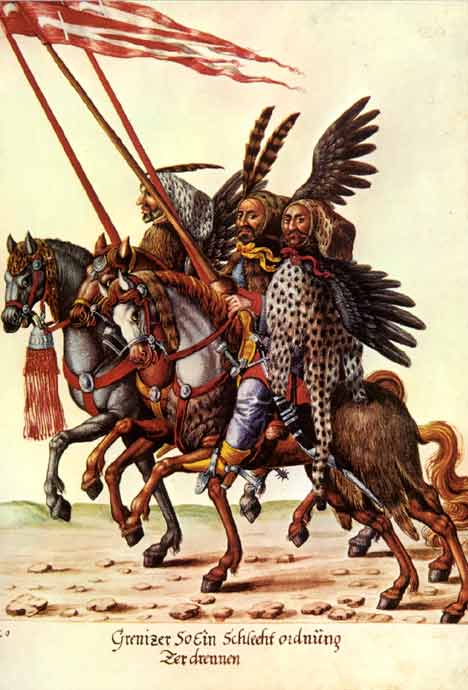
 |
|
|
|
|
#1 |
|
Member
Join Date: Jan 2006
Location: Kent
Posts: 2,658
|
Cool links Bill
  Hi Jim  , ,the Japanese horsemen often had a banner attached to their backs ....for identification purposes. They tended to be 'light' cavalry and many accounts of their battles describe that after the initial charge, fighting on horseback tended to end up in 'dog fights' ( the aerial type ...not canine  ) Because of this ....rapid ID'ing of horsemen was essential to prevent 'friendly fire'. ) Because of this ....rapid ID'ing of horsemen was essential to prevent 'friendly fire'. My understanding is that the Hussars fought in similar manner ....using tactics 'learned' from their battles with 'Eastern' neighbours, many of which were traditionally excellent horseman. These tactics also did very well against 'Western' opponents...whom were unfamiliar with these strategies. I suspect there are several reasons for the wings...they are impressive  , giving more height to the rider, obscuring the view of those being 'charged' (making it difficult to estimate the number coming towards you..... making it difficult to make quick, counter/defensive decisions) and 'rapid' identification of the riders. , giving more height to the rider, obscuring the view of those being 'charged' (making it difficult to estimate the number coming towards you..... making it difficult to make quick, counter/defensive decisions) and 'rapid' identification of the riders.A nice touch is the fact the wings tended to be made from eagle feathers (an important icon of the area). Kind Regards David |
|
|

|
|
|
#2 |
|
Member
Join Date: Mar 2005
Location: USA Georgia
Posts: 1,599
|
"We saw it .... the Hussars let loose their horses. God, what power! They ran through the smoke and the sound was like that of a thousand blacksmiths beating with a thousand hammers.
We saw it ...Jesus Maria! The elite's lances bent forward like stalks of rye, driven by a great storm, bent on glory! The fire of the guns before them glitters! They rush on to the Swedes! They clash into the Swedish riders ... Overwhelm them! They crash into the second regiment -- Overwhelmed! Resistance collapses, dissolves, they move forward as easily as if they were parading on a grand boulevard. They sliced through the whole army already! Next target: the regiment of horse guards, where stands the Swedish King Carol. And the guard already wavers!" Description from "Potop "Deluge" by Henryk Sienkiewicz. We need an icon for "shivers!" 
|
|
|

|
|
|
#3 | |
|
Arms Historian
Join Date: Dec 2004
Location: Route 66
Posts: 10,733
|
Quote:
Bill, you are indeed a true romantic!!!  and the images of the film clip you linked, along with these quoted passages evoke almost indescribable emotion, which even 'shivers' barely touches!!! and the images of the film clip you linked, along with these quoted passages evoke almost indescribable emotion, which even 'shivers' barely touches!!!Amazing! and thank you for sharing them. All the best, Jim |
|
|
|

|
|
|
#4 | |
|
Arms Historian
Join Date: Dec 2004
Location: Route 66
Posts: 10,733
|
Quote:
Nicely done, and thank you for the great illustrations. All the best, Jim |
|
|
|

|
|
|
#5 | |
|
Arms Historian
Join Date: Dec 2004
Location: Route 66
Posts: 10,733
|
Quote:
Hi David, I wanted to thank you again for your as usual, most astute, inclusion of this example of tall, mounted objects in the form of banners, by Japanese Samurai in this discussion. While we seem to have agreed that the use of the Polish hussar wings in battle was unlikely, I think your example of the use of these banners seems to the contrary, and these banners were indeed used. The point of preventing 'friendly fire' is also an important topic, which evolved into the use of identifying devices, colors or items by troops in battle to accomplish this important feature. From the well discussed heraldry of medieval knights to botanicals used in India and by Scottish clans, to the ultimate development of uniforms worn by armies....including identifying insignia...which brings us back to the Polish Hussars and their more modern use of the wing...this would be interesting to review also. Perhaps more on the Samurai banners, and of course weaponry would be another great topic here!! All the best, Jim |
|
|
|

|
|
|
#6 |
|
Member
Join Date: Mar 2005
Location: USA Georgia
Posts: 1,599
|
This deserves a bump!!
|
|
|

|
|
|
#7 |
|
Member
Join Date: Mar 2005
Location: USA Georgia
Posts: 1,599
|
This deserves a bump!!
Oops, accidental double bump! |
|
|

|
|
|
#8 | |
|
Member
Join Date: Jul 2009
Location: Slovakia
Posts: 48
|
Quote:
 In addition to this I'm in a preparatory stage for a diploma thesis that partly touches the issue of "bordermen" on the Ottoman-Hungarian frontier... some of these "nasty folks" also carried wings as well. Furthermore wings (and feathers) from birds of prey were only a part of the overall "vicious" attire - add animal hides(for both man and horse) from bears, lynxes, wolves, hyenas , lions and a pair of large spurs as well.  Ottoman bordermen (Grenizer) from cca 1590:  These are probably the "Serbs" Jim reffered to in his OP (such units also included Muslim Bosniaks and Albanians-but more on these later when you come up with questions  ) )Cheers, Samuel |
|
|
|

|
 |
|
|